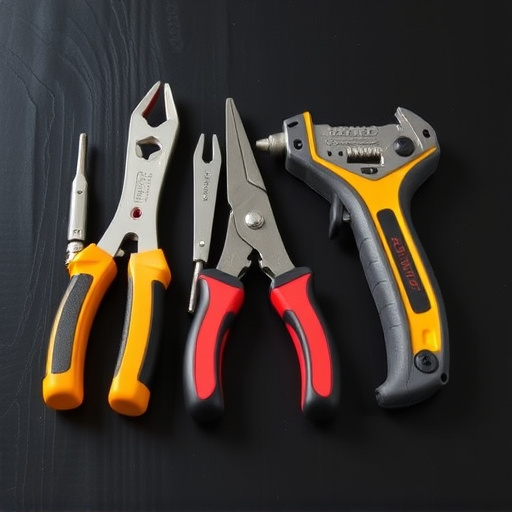Fleet Collision Services: Safeguarding Assets, Enhancing Business

Protecting commercial fleets is key for business continuity. Fleet collision services offer expert r…….
In today’s interconnected world, efficient and safe transportation systems are the backbone of global economies and societies. Among the various facets of transportation management, fleet collision services stand out as a critical component aimed at minimizing accidents, mitigating risks, and optimizing vehicle operations. This comprehensive article delves into the intricacies of fleet collision services, exploring its definition, global impact, economic implications, technological innovations, regulatory landscape, challenges, and future prospects. By the end, readers will gain a profound understanding of this dynamic field and its pivotal role in shaping safer and more sustainable transportation networks.
Definition: Fleet collision services encompass a suite of specialized solutions, processes, and technologies designed to prevent, manage, and respond to collisions involving commercial vehicles, such as trucks, buses, taxis, and delivery vans. These services aim to minimize the human, financial, and environmental costs associated with vehicle accidents by providing efficient collision management, repair coordination, and risk mitigation strategies.
Core Components:
Collision Detection and Notification: Advanced sensors, GPS tracking, and telematics systems enable real-time monitoring of fleet vehicles, facilitating immediate detection of collisions or unusual driving patterns.
Emergency Response Coordination: Fleet managers collaborate with specialized collision response teams to coordinate emergency services, including medical assistance, fire departments, and police, ensuring swift and effective incident management.
Vehicle Inspection and Repair: Comprehensive inspection protocols, coupled with a network of certified repair facilities, ensure that damaged vehicles undergo thorough assessments and repairs, adhering to safety standards.
Risk Assessment and Mitigation: Data analytics plays a pivotal role in identifying high-risk driving behaviors, geographic areas prone to collisions, and potential hazards. This information informs targeted interventions to enhance driver safety and fleet performance.
Historical Context: The concept of fleet collision services has evolved over the past few decades, driven by increasing traffic volumes, stringent safety regulations, and advancements in technology. Historically, collision management was largely reactive, relying on post-accident investigations and manual record-keeping. However, with the advent of telematics, GPS tracking, and data analytics, fleet collision services have become increasingly proactive, enabling real-time risk assessment and more efficient incident response.
International Influence: Fleet collision services are a global phenomenon, albeit with regional variations. The impact of these services is evident across developed and developing nations, contributing to improved road safety, reduced insurance claims, and enhanced operational efficiency for fleet operators.
Key Trends:
Digital Transformation: The integration of digital technologies, including artificial intelligence (AI), machine learning (ML), and the Internet of Things (IoT), is reshaping fleet collision services. These innovations enable predictive analytics, automated incident reporting, and more intelligent decision-making.
Telematics as a Cornerstone: Telematics systems are increasingly standard across fleets, providing real-time data on vehicle location, speed, and behavior. This data empowers fleet managers to make informed decisions, enhance driver performance, and optimize routes.
Global Harmonization of Safety Standards: International collaborations and regulatory bodies are working towards harmonizing safety standards, facilitating the adoption of best practices in fleet collision management across borders.
Regional Differences:
North America: The United States and Canada lead in terms of advanced telematics deployment and data-driven collision management. Strict safety regulations and a mature insurance industry have fueled the adoption of fleet collision services.
Europe: The European Union’s emphasis on road safety has led to robust collision data collection and detailed risk analysis. Countries like Germany and the UK are known for their sophisticated fleet management systems.
Asia-Pacific: Rapidly growing economies in this region, such as China and India, are witnessing increased fleet operations, driving demand for efficient collision management solutions.
Market Overview: Fleet collision services represent a significant segment within the broader transportation and logistics industry. The market is characterized by diverse participants, including technology providers, insurance companies, fleet managers, and specialized collision response services.
Investment Patterns:
Technology-Driven Investments: Significant funding is allocated to research and development of advanced technologies, particularly in AI, ML, and IoT applications for fleet collision management.
Telematics Adoption: The global telematics market, a key enabler of fleet collision services, is projected to reach USD 78.5 billion by 2026, driven by the growing need for real-time vehicle tracking and monitoring.
Economic Impact:
Cost Savings: Efficient collision management can lead to substantial cost savings for fleet operators through reduced insurance premiums, lower repair expenses, and minimized downtime due to accidents.
Increased Productivity: Proactive collision prevention strategies enhance fleet productivity by minimizing delays caused by accidents, leading to improved operational efficiency.
Risk Management: Fleet collision services contribute to risk mitigation, enabling companies to manage exposure to liability claims, regulatory fines, and potential reputational damage associated with accidents.
Recent Breakthroughs:
Artificial Intelligence (AI) and Machine Learning (ML): AI and ML algorithms are revolutionizing fleet collision services by analyzing vast amounts of data to predict accident-prone areas, identify risky driving behaviors, and optimize vehicle routing.
Advanced Driver Assistance Systems (ADAS): These systems, featuring features like automatic emergency braking, lane departure warning, and adaptive cruise control, play a crucial role in preventing collisions and enhancing driver safety.
Internet of Things (IoT) Integration: IoT sensors embedded in vehicles enable continuous monitoring of critical parameters, such as tire pressure, engine performance, and brake health, facilitating proactive maintenance and collision risk assessment.
Future Potential:
Autonomous Vehicles: The rise of autonomous fleets has the potential to significantly impact collision services, with self-driving vehicles equipped with advanced sensors and AI capabilities aiming to eliminate human error-related accidents.
Data Analytics Platforms: Advanced data analytics platforms will enable more sophisticated risk assessment, predictive modeling, and real-time decision-making, enhancing fleet safety and operational efficiency.
Blockchain for Record-Keeping: Blockchain technology can revolutionize collision record-keeping, ensuring secure, immutable, and transparent data sharing among stakeholders, including insurers, fleet managers, and repair shops.
Key Policies and Regulations:
Safety Standards and Regulations: Governments worldwide have enacted stringent safety standards and regulations to govern fleet operations, vehicle maintenance, and driver qualifications. These rules provide a framework for effective collision management practices.
Insurance Industry Guidelines: Insurance companies play a crucial role in promoting safe fleet operations by setting guidelines for risk assessment, pricing, and claims settlement related to vehicle collisions.
Data Privacy Laws: As fleet collision services rely heavily on data collection, compliance with data privacy laws, such as GDPR in Europe or CCPA in the US, is essential to protect sensitive information.
Influence on Fleet Collision Services:
Standardization: Regulatory bodies set standards for collision reporting, data sharing, and repair procedures, ensuring consistency and compatibility across different jurisdictions.
Accountability and Liability: Regulations define liability frameworks, ensuring that fleet operators, drivers, and other stakeholders are held accountable for their roles in preventing and managing collisions.
Incentives for Safety: Some policies offer incentives or subsidies to fleet operators who implement advanced safety technologies and collision management practices, fostering a culture of safety.
Common Challenges:
Initial Implementation Costs: Implementing advanced telematics, ADAS, and data analytics solutions can be expensive for smaller fleet operators, creating a potential barrier to entry for these services.
Data Security and Privacy Concerns: The collection and sharing of vast amounts of vehicle and driver data raise privacy concerns, necessitating robust security measures and compliance with relevant laws.
Resistance to Change: Fleet managers and drivers may resist adopting new technologies or processes, requiring comprehensive training and communication strategies to facilitate a smooth transition.
Proposed Solutions:
Government Incentives: Governments can offer subsidies or tax benefits to encourage smaller fleets to invest in fleet collision services and advanced safety technologies.
Partnerships and Collaboratives: Fleet operators can collaborate with technology providers and insurance companies to share data, resources, and expertise, fostering innovation and cost savings.
Targeted Training Programs: Developing comprehensive training programs for drivers and fleet managers on new technologies, data interpretation, and collision management best practices is essential.
Case Study 1: Proactive Collision Prevention in Urban Fleets
Location: Amsterdam, Netherlands
Challenges: The city’s dense traffic and high pedestrian volume made accident prevention a top priority for local authorities.
Solution: The city introduced an advanced fleet management system utilizing AI-powered analytics to predict collision hotspots and optimize vehicle routing. Real-time data from sensors and cameras enabled immediate incident response, while predictive models helped in long-term strategic planning.
Results: A 30% reduction in traffic accidents within the first year, leading to fewer fatalities, injuries, and property damage claims. The system also contributed to improved traffic flow and reduced congestion.
Case Study 2: Data-Driven Collision Management in Long-Haul Trucking
Location: North America (Multi-state)
Challenges: Long-haul trucking companies face significant challenges related to driver fatigue, long hours, and varying road conditions across states, increasing collision risks.
Solution: A major trucking company implemented a fleet collision services platform that integrated telematics, driver behavior monitoring, and advanced analytics. The system provided real-time alerts on unsafe driving patterns, fatigued drivers, and adverse weather conditions.
Results: A 25% decrease in collision rates over two years, with corresponding reductions in insurance claims, repair costs, and driver turnover. The platform also improved fuel efficiency by optimizing routes and minimizing idle time.
Case Study 3: Collaborative Collision Response in Shared Mobility Services
Location: Singapore
Challenges: With the rise of ride-sharing and car-sharing services, efficient collision response becomes more complex due to dynamic fleet operations and diverse insurance policies.
Solution: A collaborative approach was adopted where shared mobility providers partnered with specialized collision response teams and insurance companies to streamline incident management. This involved standardized procedures, real-time data sharing, and integrated communication platforms.
Results: Significantly reduced response times, leading to improved customer satisfaction and safety. The collaboration also simplified insurance claims processing, minimizing administrative burdens for all parties involved.
Emerging Trends:
Autonomous Fleets: The future of fleet collision services is closely tied to the evolution of autonomous vehicles. As self-driving technology advances, fleets will become increasingly automated, reducing human error and enhancing safety.
Hyper-Local Data Analytics: With the proliferation of IoT devices and sensors, hyper-local data analytics will enable more precise risk assessment and targeted interventions at specific locations and conditions.
Blockchain Integration: Blockchain technology is poised to revolutionize collision record-keeping, insurance claims processing, and cross-border data sharing, ensuring transparency, security, and interoperability.
Growth Areas:
Emerging Markets: Rapidly developing economies in Asia, Africa, and Latin America present significant growth opportunities for fleet collision services, driven by increasing vehicle ownership and urbanization.
Specialized Services: Niche areas such as emergency medical transport, hazardous material hauling, and specialized vehicle maintenance will demand tailored collision management solutions.
Strategic Considerations:
Data Security and Privacy: As data becomes more valuable, ensuring robust security measures and adhering to evolving privacy regulations will be critical for maintaining trust among stakeholders.
Regulatory Compliance: Keeping pace with changing regulations and industry standards will be essential to avoid legal complications and ensure effective collision management practices.
Sustainability Focus: With growing environmental concerns, fleet collision services can contribute to sustainability by promoting fuel efficiency, minimizing waste, and facilitating the adoption of eco-friendly vehicles.
Fleet collision services have evolved from a niche concern to a critical component of modern transportation management, driven by technological advancements, regulatory demands, and a relentless pursuit of safety and efficiency. As the world navigates an increasingly interconnected and complex transport landscape, these services will continue to play a pivotal role in shaping safer, more sustainable, and resilient transportation systems globally.
By embracing emerging technologies, fostering collaboration among stakeholders, and addressing challenges proactively, the future of fleet collision services promises enhanced safety, improved operational efficiency, and reduced environmental impact. As the industry continues to evolve, continuous innovation, data-driven decision-making, and a commitment to best practices will be essential to unlock the full potential of fleet collision services in tomorrow’s world.
Q: How do fleet collision services differ from traditional insurance claims processing?
A: Fleet collision services go beyond traditional insurance by providing proactive risk management, real-time incident response, and data-driven insights to prevent accidents and optimize operations. They also streamline claims processing internally within the organization, offering a more efficient experience for drivers and companies.
Q: What role does telematics play in fleet collision management?
A: Telematics systems, with their ability to track vehicle location, speed, and behavior in real-time, are essential for fleet collision services. They enable immediate detection of collisions or unusual patterns, facilitate efficient incident response, and provide valuable data for risk assessment and performance monitoring.
Q: How can fleet operators ensure data privacy while leveraging advanced technologies?
A: Fleet operators should implement robust data security measures, including encryption, access controls, and regular security audits. Compliance with relevant data protection regulations, such as GDPR or CCPA, is crucial. Additionally, transparent data-sharing practices with stakeholders can build trust and foster long-term partnerships.
Q: What are the potential benefits of autonomous vehicles in fleet collision services?
A: Autonomous vehicles have the potential to significantly reduce collision rates by eliminating human error, a leading cause of accidents. Advanced sensors and AI algorithms can detect hazards and navigate complex situations more effectively than humans. Fleet collision services can leverage these capabilities to enhance safety, optimize routes, and minimize downtime associated with accidents.

Protecting commercial fleets is key for business continuity. Fleet collision services offer expert r…….

Stringent safety standards have made fleet collision services essential in the auto industry. These…….

Fleet collision services are essential for commercial vehicle safety and efficiency, offering frame…….

Fleet collision services offer tailored solutions for large fleet businesses, prioritizing minimal d…….

Investing in fleet collision services minimizes risk, saves time and money, protects vehicle value,…….

Fleet collision services streamline auto repairs for businesses with multiple vehicles, offering cen…….

Fleet collision services are crucial for road safety, repairing vehicles post-accidents from minor d…….

Fleet collision services leverage advanced technologies and specialized training to deliver exceptio…….

Fleet collision services streamline vehicle recovery for businesses, offering specialized repairs an…….